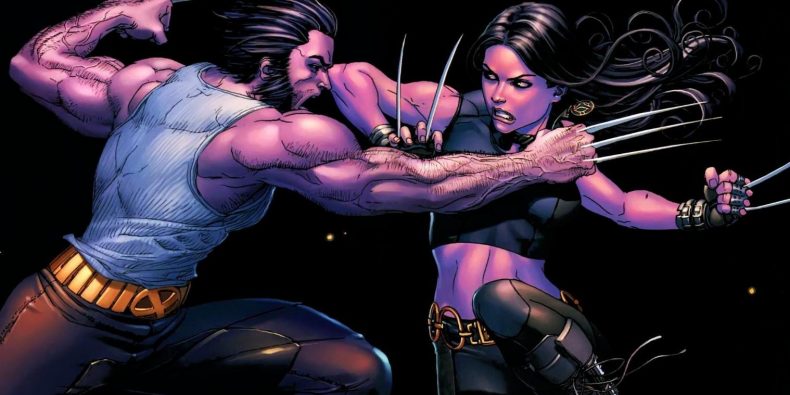Updated 03/06/2017: Added an extensive “Logan” section.
Before we start this off, let me make one thing clear – X-23 is my all-time favorite Marvel character. Trust me, there’s a whole lot of Marvel characters I really love, but she is definitely at the top of that list. She first started to become really prominent in the Marvel universe in 2005, which was when I first began to seriously get into comics. We were the same age, and since she’s aged more or less in real time since then, I’ve always felt a connection to her, almost like she was a childhood friend I grew up alongside. I don’t know, maybe I’m just being melodramatic, but that’s how I feel. As such, it fills my heart to see her finally make her well-deserved big-screen debut in what just may be the best X-Men movie we’ve had to date. So, to commemorate the occasion, I decided to go back through the character’s history, from her very first appearance all the way down to her modern day romps as Wolverine. There’s a lot of ground to cover, so obviously I won’t be able to talk about every single story in which X-23 appears, but I’ll try to hit all of the important bases. With that said, let’s not waste any more time and get right down to it!
Debut in “X-Men Evolution”
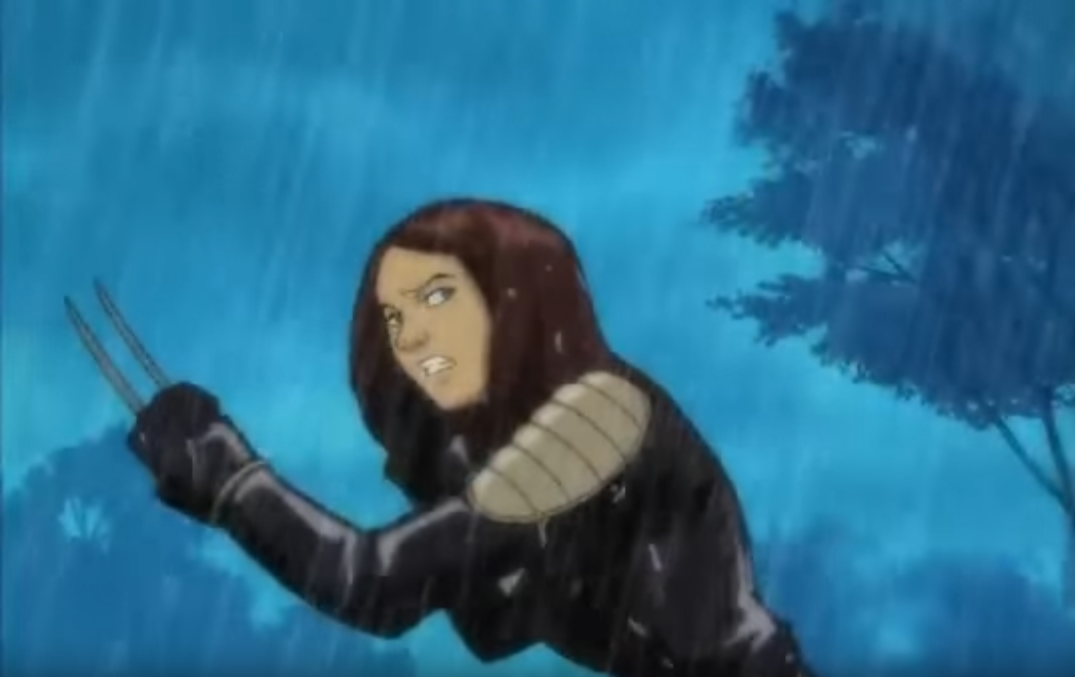
Much like DC’s Harley Quinn, X-23’s first appearance wasn’t actually in the comics – it was in the highly underrated early 2000s animated show X-Men Evolution, created by Marty Isenberg, Robert N. Skir and David Wise. For the sake of brevity, we won’t talk much about the show other than mention that it was basically what an X-Men cartoon should have always been about, namely students in a school discovering their powers. X-23 first appeared in the episode bearing her name, which aired on August 2, 2003 and was written by Craig Kyle and Chris Yost, who share the credit for her creation. The waters are a bit murky when it comes to which of the writers contributed what, but judging from what I’ve read, I’m willing to believe that Kyle was the primary creative drive while Yost provided backup. Still, credit should be given where credit is due, and I don’t mean to undermine Yost’s involvement in the process – as future projects will show, he’s just as committed to the character as Kyle, so it absolutely sucks that Marvel don’t even mention his name when talking about her these days.
If there’s one thing that you might have immediately noticed about Evolution’s take on X-23, it’s that she looks very different from the character we’ve come to know in the comics. Her hair and eyes are brown instead of black and green, and most notably, her skin is a darker complexion than that of her counterpart. That’s no coincidence – as Craig Kyle explained in an interview, the original X-23 design was based on a real child, namely an 11 year old girl that his wife was babysitting at the time. In order to have a reference for the character designers, Kyle fashioned two pairs of claws, gave them to the girl and then took a few photos of her as X-23, and I’ve got to be honest… I kind of sort of really want to see those pictures. If they still exist, that would be the very first graphic depiction of my favorite character! If you are that girl, please step forward – I’d give just about anything for an interview with you!
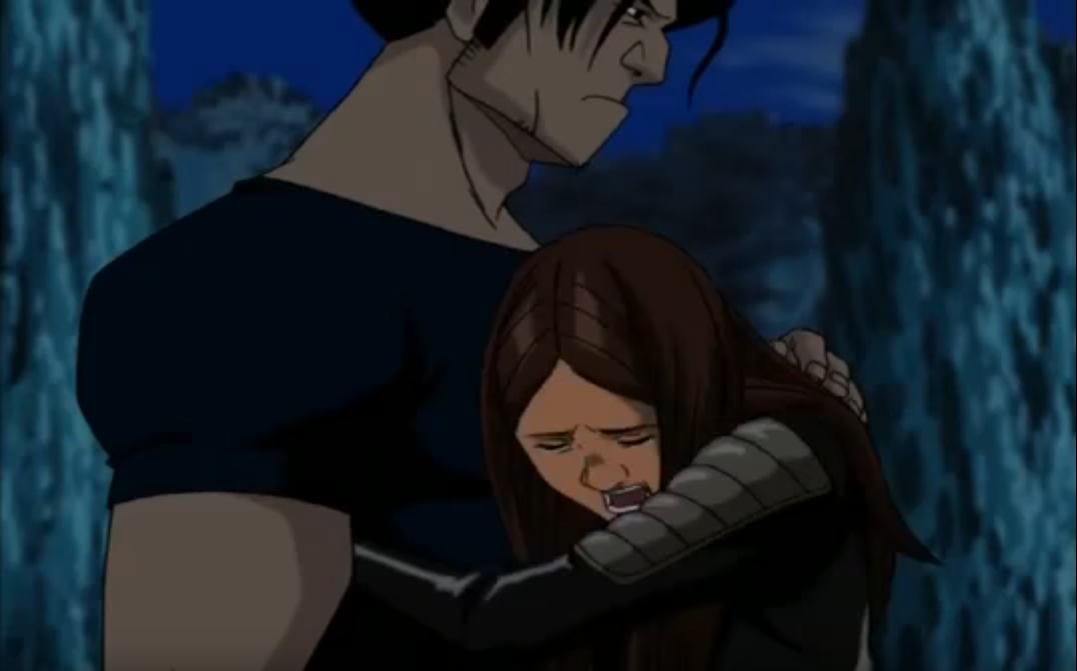
Once you start watching the episode, you’ll quickly realize that her looks aren’t the only thing that is different between her comic and cartoon counterpart. Basically the only thing they share is an origin, in that they’re both clones of Wolverine trained since birth to be assassins. But while the comics thoroughly explore the psychological damage that such an upbringing would have on a child, in the show X-23 just comes off as a whiny little girl that complains a lot. Andrea Libman voices her in her first appearance, and while she’s typically a fantastic voice actress most notable for her roles as Fluttershy and Pinkie Pie on My Little Pony: Friendship is Magic, here she just comes off as grating and annoying. There’s certainly strength in X-23’s actions as she singlehandedly takes out every single student and teacher at Xavier’s Institute with ease as she tries to get to Wolverine, but beyond that, she comes off as a little brat. Maybe that was the intention. Maybe Kyle and Yost were hoping that, by having her act like a seven year old throwing a temper tantrum, they would underscore that she’s really a child and not the weapon that her creators meant her to be. For me, however, it didn’t work at all.
Her next appearance, in the episode “Target X” (which aired a mere month later), presents her in a much stronger light. This time, X-23 is calm and composed. She’s got a plan, she sticks by it, and she does some real damage to the bad guys. Really, despite the fact that Wolverine is the main character of the episode, she basically treats him like an incompetent sidekick at times, and I say that in the best possible way. I don’t know, maybe it’s also because X-23 has a different voice actress in this episode (Britt Irvin replaced Libman), but she seems a whole lot stronger and more independent than before. I personally enjoyed her portrayal in Target X a lot more than in her debut episode, and apparently, so did the folks over at Marvel, because she made her debut in the comics literally less than 3 months after that episode aired! The problem is, that debut was not, um… Well… Handled with a whole lot grace.
Comic Debut
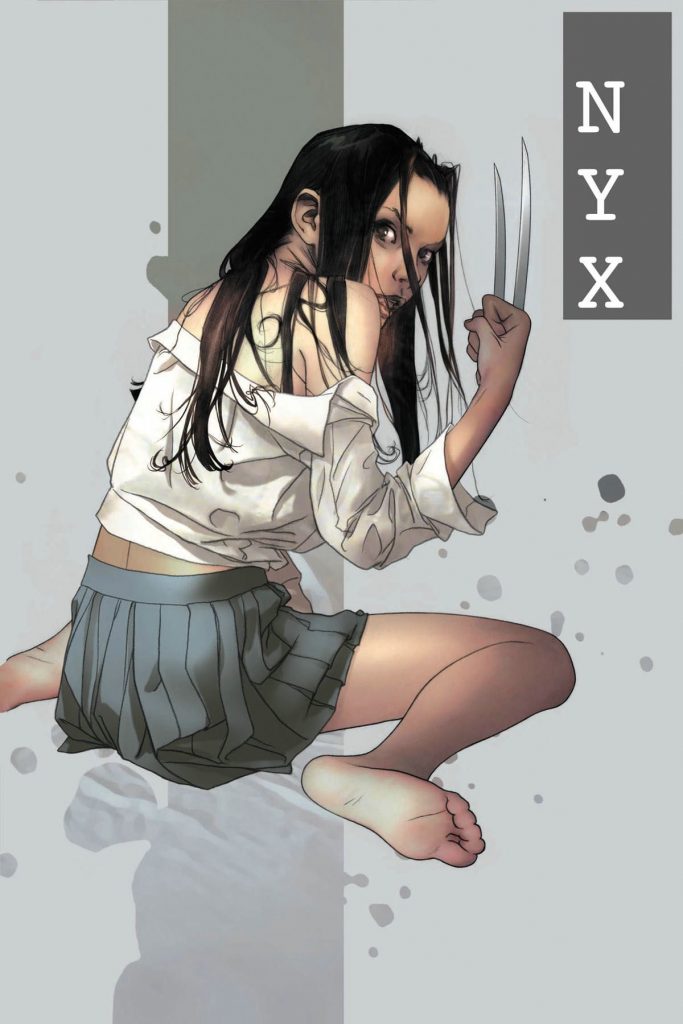
X-23 made her first appearance on the pages of Marvel comics in December 2003, in issue 3 of NYX. Now, the thing that you must absolutely understand about NYX is that its first issue came out in October 2003 – a mere two months after X-23’s very first TV appearance. As you may know, comic books (even those created by major publishers) take a whole lot of time to make, so chances are the storyline of NYX was already written and submitted way before anyone had any idea some character that just appeared on a children’s TV show would have to be included. Keep in mind that this is nothing but speculation, but my own, personal guess is that when Marvel saw the warm reception X-23 got in Evolution they immediately decided to force her into the first X-Men peripheral title they could in order to gauge how comic book readers respond to her. The writer (be it Zeb Wells, who penned the first issue, or Joe Quesada, who took over afterwards) had no time to alter his plot to accommodate her inclusion, so he basically just replaced one of his own original characters with her in order to keep the higher-ups happy. It’s honestly the only explanation that makes sense to me, because the X-23 in NYX has absolutely nothing to do with the 11 year old assassin you saw on TV.
No, in this story, the girl is already a teenager (with a redesign to make her appear more like Wolverine, which makes sense), but she’s not an assassin. She’s not on the run from people trying to turn her into a weapon.
She’s a prostitute.
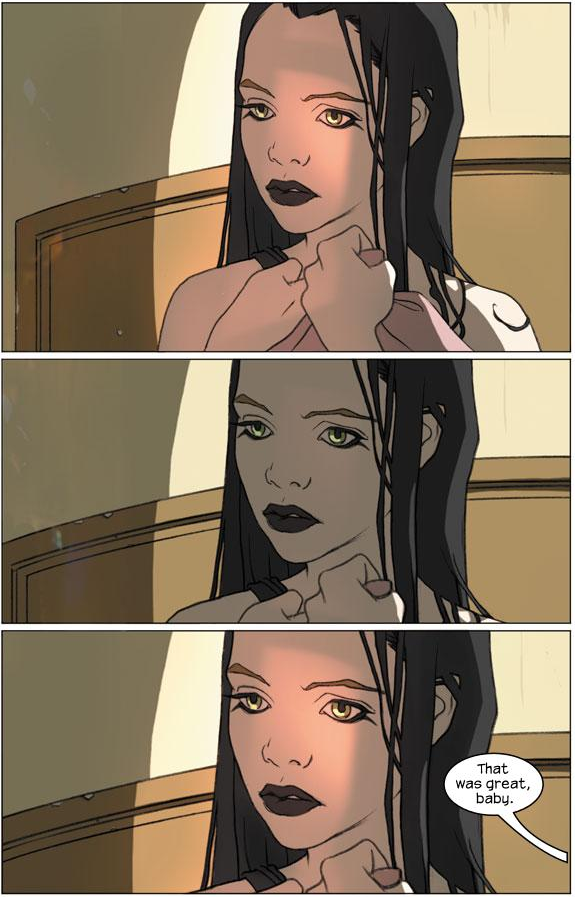
Oh, how I wish I was making that up. Yes, someone somewhere along the chain of command (most likely Joe Quesada, who was the writer of most of NYX AND Marvel’s editor-in-chief at the time), honestly thought to themselves “Hey, you know what would be the best way to introduce this character that was very popular on a cartoon aimed at the 8-10 demographic? Make her a teenage prostitute, that really seems reasonable!” And I don’t mean to sound like a prude who is against depictions of sex workers in comic books, but introducing this particular character in such a way is downright insulting. Needless to say, practically every single future writer has completely ignored this story. It has been explicitly referenced exactly once in X-23’s 13 year history, and even that completely ignored the “teen prostitute” nonsense. It’s not a good story in its own right, and what it did to X-23 is even worse. Thank God X-Men messiah Chris Claremont came to clear up that mess, because if he hadn’t, I’m fairly certain you wouldn’t have been reading this article right now.
Joining the X-Men
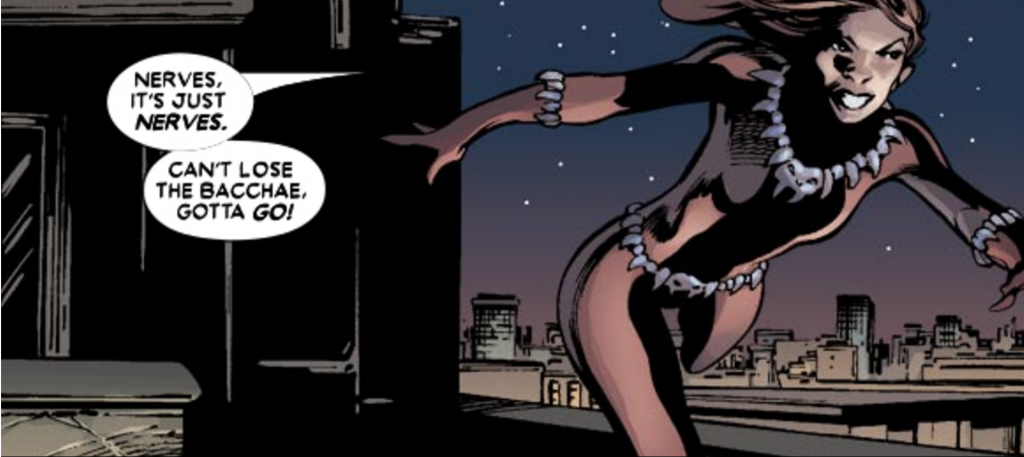
Almost every Marvel hero has this one writer that came in and basically contributed the majority of their best stories, you know, the ones that you keep seeing adapted into movies over and over again. Todd McFarlane did it with Spider-Man, Ed Brubaker did it with Captain America, hopefully Matt Fraction’s going to do it with Hawkeye whenever Marvel finally makes that movie or TV show, and then there’s Chris Claremont and the X-Men. You know, the guy that gave us Days of Future Past, the Dark Phoenix saga, God Loves, Man Kills (partially adapted into X2) and oh so many more fantastic stories. So when he says “Screw it, I’m gonna bring X-23 into canon myself”, you know you’re in for a treat.
Her very first meeting with the team happened in Uncanny X-Men #450 and the following issue, which were meant to celebrate Wolverine’s 30th anniversary. And what better way to celebrate than to introduce a genderbent clone with questionable fashion sense? Seriously, look at the thing she’s wearing! I love how Craig Kyle went as far as to find a real little girl and build her claws only so that the designers could recreate the character exactly how he imagined her, while Claremont just went “Y’know what, just make her, like, tribal or something, who cares”. I don’t mean to be too harsh on Claremont because I still really like the story in which she’s introduced, but dear God am I glad that she never kept that outfit!
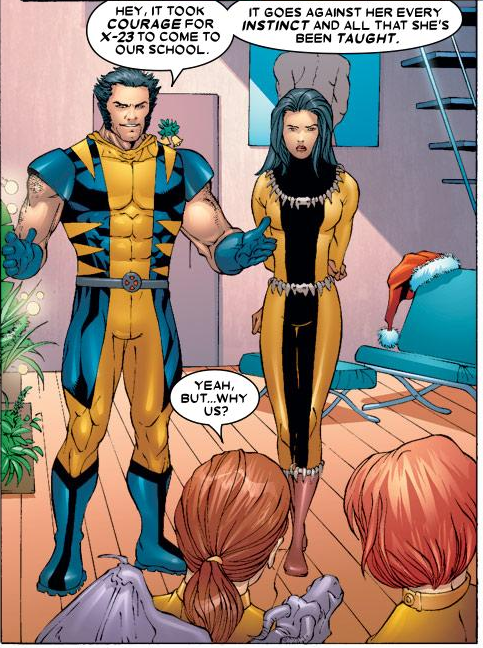
In the story, Wolverine gets framed for the murder of several thugs, who were apparently killed by his claws. That prompts the X-Men to investigate, and they discover that X-23 is the culprit, but she was really only trying to protect her new friend (who is a mob boss’ daughter). It’s a heartwarming story which showcases the three qualities that I believe define X-23 – one, she doesn’t know a whole lot about the world; two, she’s scarily good at killing people; and three, you really don’t want to harass anyone she considers a friend. She officially joins the X-Men in the Christmas special of their main book (X-Men #165, which came out in December 2004), where she once again demonstrates those three qualities. A particular moment that will always stick out to me is when a family X-23 and the X-Men saved earlier in the issue come along to the X-Mansion to express their thanks, only for her to absentmindedly invite them to celebrate Christmas with them. The family is, naturally, very reluctant to spend the holidays with a bunch of mutants, which immediately causes X-23 to feel awkward about it, but Wolverine won’t have any of it – she did the right thing.
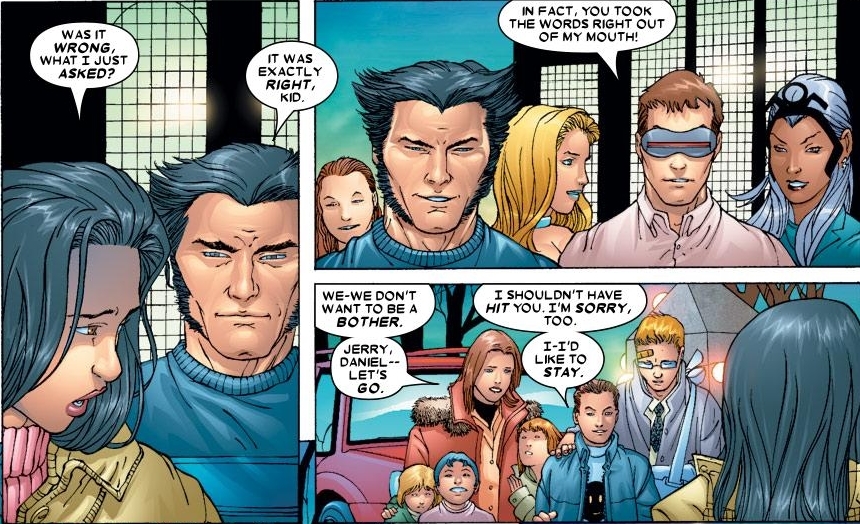
I believe that Claremont had the same idea as Kyle, in that he was trying to portray X-23 as a child, but instead of showing her off as an annoying, whiny brat, he capitalized on innocence, naivete and lack of experience with the world, among other child-like qualities. Sure, what he did with her wasn’t perfect (she still talks like a regular kid despite the fact that she was raised with very little social contact, and it’s also explicitly stated that her entire skeleton has been bonded with adamantium – something that couldn’t possibly be true without majorly stunting her development, and was retconned less than a year later), but it was a great way to properly introduce X-23 into the main Marvel continuity. Now that she’s been properly established as part of the X-Men, the only thing left to do is to go back and give her a proper comic book origin, and who better for the job than the people who created her, Craig Kyle and Chris Yost? And boy oh boy, you guys are in for a treat!
Origins
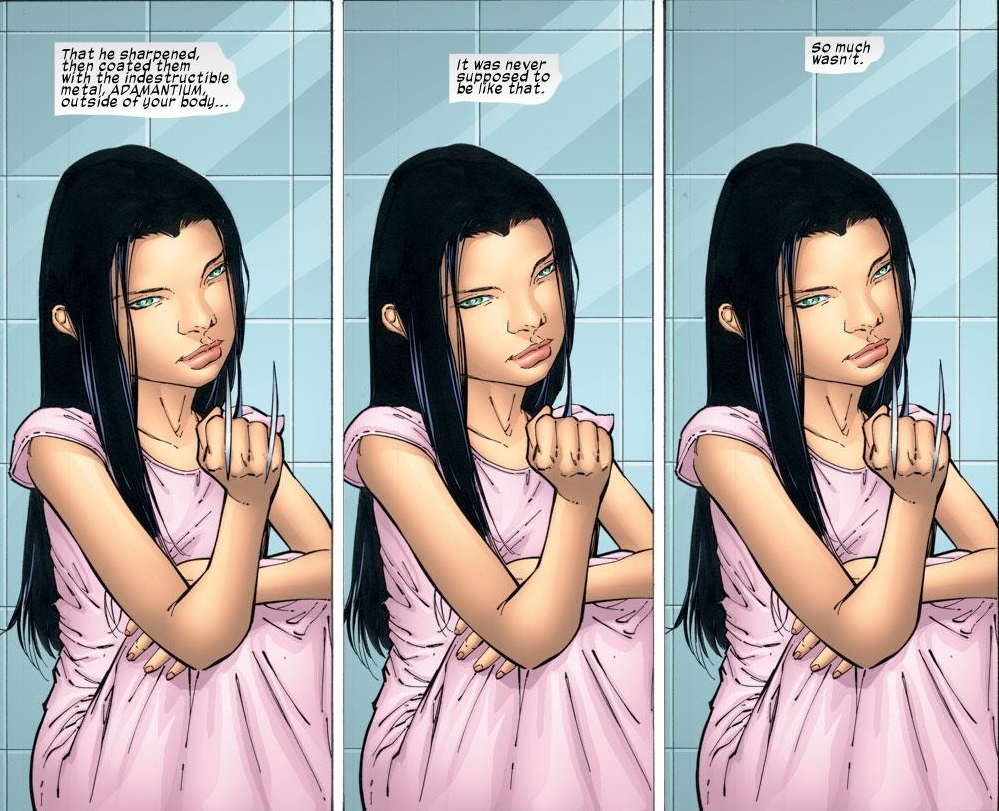
The six issue mini-series X-23: Innocence Lost, whose first issue released in January 2005, might just be the single best mini-series I have ever read in my life. It was my introduction to X-23, and I’m confident that I couldn’t have picked a better place to start. It is AMAZING, on every conceivable level. Kyle and Yost have managed to craft a narrative that is leagues above what most comic book miniseries were doing at the time (and, honestly, would continue to do for years to come). It’s no coincidence that the X-23 found in Logan is precisely the very same one from Innocence Lost rather than from her later, more popular appearances. I’m certain that the story itself could translate well into a movie with minimal alterations. I don’t know, maybe I’m just biased because it was one of the stories that got me into comic books, period, but no matter how many times I re-read it, it STILL holds up to this very day.
Surprisingly, the story actually isn’t about X-23 at all. Actually, that’s not quite right – it is about her, but she’s not the protagonist. Rather, the focus is on the struggles between the two scientists brought in to create her. Dr. Zander Rice, whose father was murdered by Wolverine during his escape from Weapon X years ago, was initially placed in charge of recreating his father’s killer, but failed every time. To aid him, his employers brought in the young, yet promising Dr. Sarah Kinney – a geneticist who suggests cloning. Zander, naturally, feels threatened by this woman who suddenly takes over his project, while Sarah continuously tries to prove herself, even at the cost of getting into trouble. As a result, she goes against orders and creates a viable female clone (as a male clone proved impossible), which Zander retaliates against by basically blackmailing her into becoming the clone’s incubator. This power dynamic continues well after X-23 has been born, with the two of them having radically different ideas on how she should be raised. Sarah promotes nurture, sneaking into her cell to read her fairy tales and to try and act as much as she can as a mother to X-23 behind Zander’s back. He, on the other hand, insists on optimizing her performance – using radiation to activate her mutation early, lacing her claws with adamantium at an early age, painfully conditioning her to a “trigger” scent that will make her go into a fit of rage if she smells it… And the thing is, you can kind of see both of their viewpoints. Zander sees X-23 as nothing more than the weapon she was meant to be, and is only doing his job of turning her into an effective killer by any means necessary, while Sarah has gotten emotionally attached to the child she sees in her, and as such isn’t always able to make the best decisions.
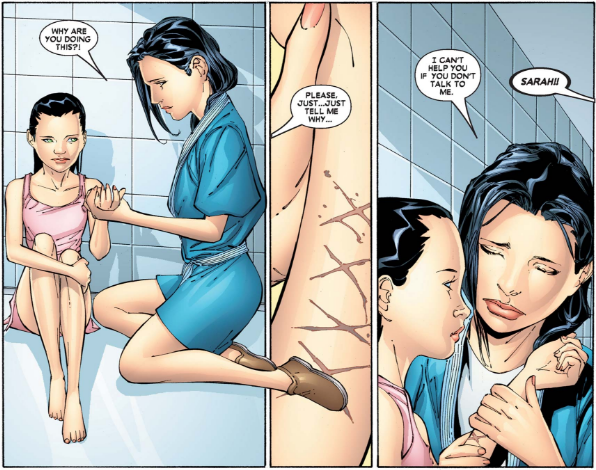
Being stuck between a rock and a hard place and spending literally all of her life from birth with minimal social contact except for when being trained to kill takes an enormous mental toll on X-23. She doesn’t speak more than a handful of words of her own accord, she cuts herself, she rarely displays any sort of emotion – all symptoms of a child that has been thoroughly abused. I won’t spoil much of the plot, but as the story progresses both Zander and Sarah start using X-23 to satisfy their own ends, prompting the little girl to escape in one of the most badass final acts ever. After a completely heartbreaking finale, the young girl decimates the facility (blowing up a whole batch of other X-clones in the process), earns her freedom, and in the process learns of her origin as Wolverine’s clone, as well as the name that her mother picked for her – Laura. Out of respect for the only person who ever loved her, X-23 takes her mother’s last name. From now on, she will be referred to as Laura Kinney. And she will never let anyone use her as a weapon again.
Misc. Adventures
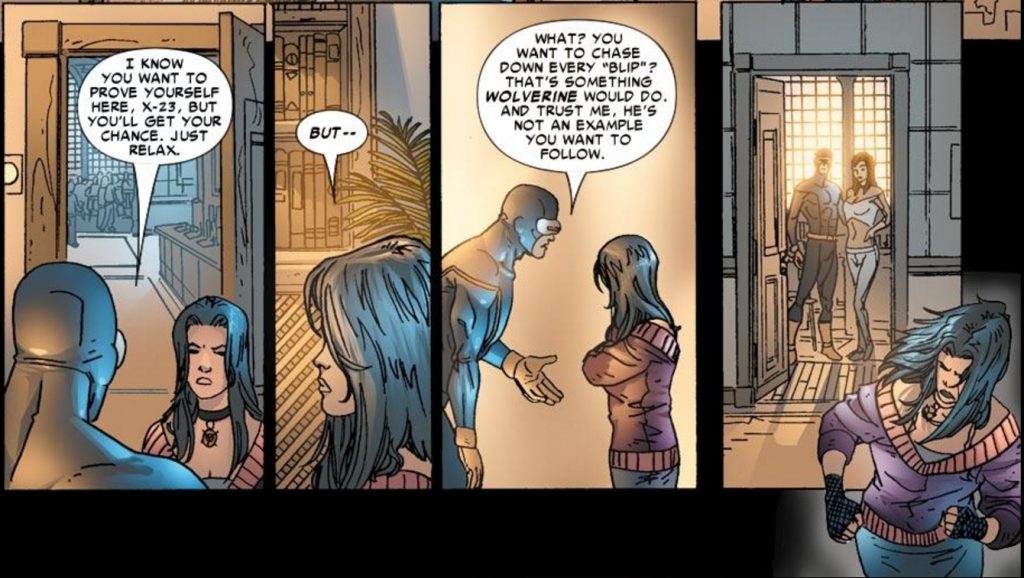
2005 was a really, really great year for X-23. After starting out with a bang in January with Innocence Lost, she made a myriad of appearances in other books throughout the year, the most notable of which is New X-Men (which I’ll talk about a little bit later, since there’s a lot of ground to cover there). I won’t be able to go into detail for all of them (because, honestly, there’s so many that I don’t even think I’ve read all of them), but I’ll try to hit on a few interesting notes that I believe are worth looking into. For example, her first appearance in a non-X-Men book is in Marvel Team-Up #5, penned by Robert “The Walking Dead” Kirkman, where she showed up twice. Interestingly enough, it’s the first time she was depicted wearing goth clothing since NYX, as far as I could tell – that particular style would become her staple during her teens. I’m not sure if Craig Kyle always envisioned her as being a goth and kinda gave Kirkman a nudge, or if Kirkman just saw NYX and was like “Hey, that’s pretty good”, but whatever the case, I like to think of him as the godfather of Gothic Laura. To me, personally, it’s kind of cheap to depict her dark, depressed emotional state in such a way, but I guess it works as useful visual shorthand, so I don’t really have a problem with it. And besides, she looks good in those kinds of clothes – I can’t deny that!
X-23’s second appearance in Marvel Team-Up placed her in a storyline called the “League of Losers”, where some evil bad guys from the future traveled back in time using information about all important superheroes in order to kill them all, thus leaving just a handful of survivors (Laura included) who weren’t notable enough to be killed. First of all, isn’t it funny how a character that’s getting the spotlight in a major motion picture was once considered part of the “League of Losers”? Second of all, didn’t those time travelers know that she would eventually become Wolverine in the not too distant future, and as such could pose a problem? I mean, if they have information on everyone that’s relevant, you’d think that future Wolverine would be at the top of their list, but oh well.
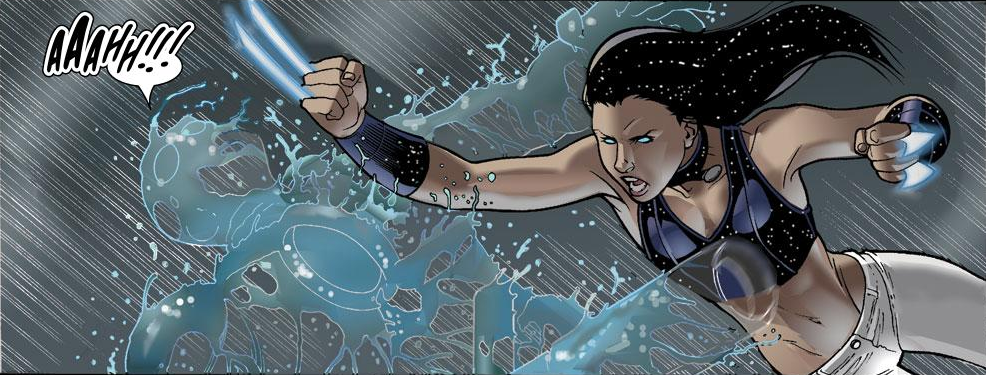
Her weirdest appearance from 2005 is definitely in November’s Captain Universe #3, with Kyle and Yost stepping in to guest-write that particular issue. Captain Universe was a weird series where a different character got cosmic powers every issue in pursuit of an overarching plot… So yeah, for the time being, X-23 was one of the few characters in the Marvel Universe, right alongside Spider-Man and the Hulk, to have wielded that power. Funny how things work. It’s important to note that this is her first formal appearance of her “modern” leather outfit, replacing the horrifyingly bad tribal suit she used to have back when Claremont wrote her in X-Men. Speaking of that, she showed up in a couple of those titles, like Uncanny X-Men, but they’re not really all that notable. It mostly showed her bonding with her teammates, making some new friends and having fun with her mutant buddies! Surely nothing horrible would befall mutantkind and ruin the good thing she’s got going for her, right? Right?
New X-Men
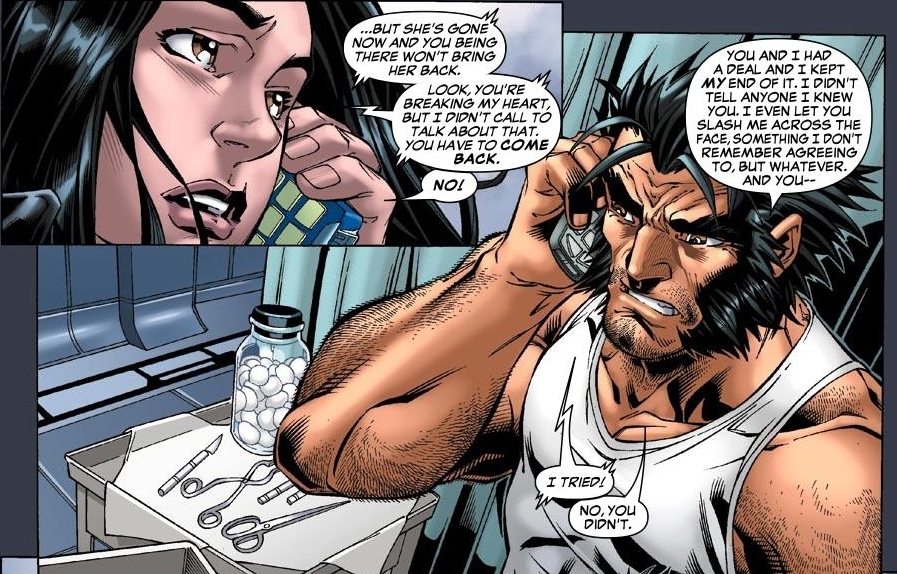
New X-Men was a fantastic book. It was one of the first X-Men books I really got into, in no small part because X-23 joined it, but even before that I found it to be surprisingly entertaining. It had very likeable characters that actually acted like teenagers in a school rather than as adults in spandex, it had enjoyable storylines and drama that didn’t feel forced or distracting, and most importantly, it was fun! Of course, that all had to end when the Decimation event happened and dealt the X-Men a blow that they still haven’t recovered from to this day. I won’t go into detail here, but essentially, the overwhelming majority of mutants lost their powers, with a good chunk of them dying because either their powers were sustaining them or because they killed themselves by trying to use abilities they no longer had, like flight. Out of hundreds of thousands of mutants across the globe, only 198 remained, including X-23. Naturally, that kind of sucked for her, especially since she lost quite a lot of friends with the X-Men that way. Not wanting to leave her alone, Wolverine convinced her to join many of the remaining mutants at Xavier’s School (run by Cyclops and Emma Frost at the time) and really try to fit in this time. She reluctantly agreed.
I have some very mixed feelings about this run, to be honest. It’s undeniably good, don’t get me wrong – I mean, with Craig Kyle at the helm, you know that Laura’s going to be treated with the respect she deserves (even if the callbacks to the people who cloned her in “Innocence Lost” felt kind of forced – her being recaptured by her creators and/or having to deal with clones of herself will be recurring themes throughout her adventures). However, the series is also undeniably dark, way darker than the first half. Characters die or get mutilated left and right, the people you’ve come to grow and love all suffer immeasurably both physically and mentally, it’s just painful to read. That’s not to say that there aren’t any moments of levity sprinkled in, such as one of my favorite moments ever, when she meets her roommate:
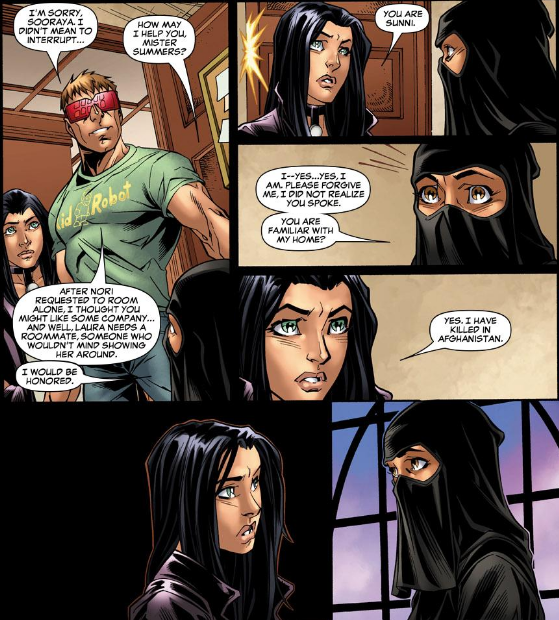
But overall, the series was just painful to read. The fact that I don’t remember ever getting to the ending, and I REALLY did not want to go back and read it for this retrospective, should be a testament to just how overbearing and foreboding the darkness was. I mean, early in the run Emma Frost, the headmistress of the school, openly tortures Laura with visions of the people she’s killed before putting all the students in a Battle Royale to determine the new team of X-Men. I mean, Jesus, comic, give me a break! I don’t entirely blame Craig Kyle for this, as it’s pretty clear that you can’t exactly go light after an event like Decimation, but at the end of the day, it just wasn’t my thing at all.
There’s a couple of things that are important to bring up from this era of X-23’s life. First and foremost, she actually did manage to end up on the team after the aforementioned Battle Royale, making her an official X-Man for the very first time (during Claremont’s run she was nothing more than a reserve member who only occasionally helped out). Interestingly enough, she also began to experiment a little bit with letting her emotions and feelings out, which netted her the interest of a teammate known as Hellion. For a while, the two of them were a thing (not exactly a couple, but more than just mutual crushes) despite the fact that they were actually pretty terrible for each other in basically every way. Even at the time, my personal theory was that Laura never actually had any feelings for Hellion, but her inherent desire to fit in and be like everyone else made her return his advances. All the other girls had boyfriends, so she needed one too, right? Let’s put a pin on this one, we’ll get back to it.
Target X
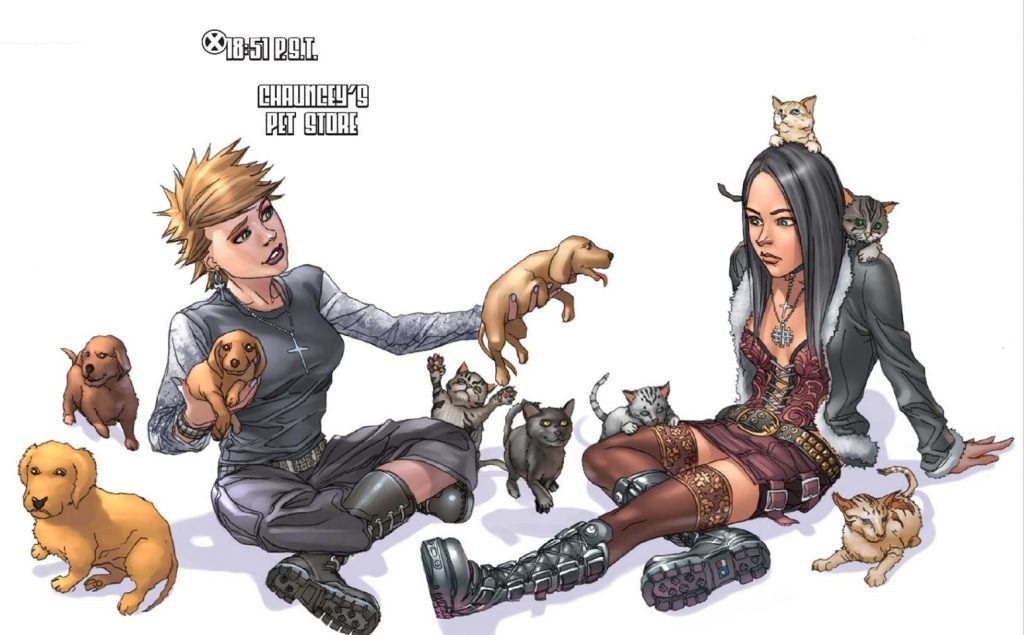
Okay, so maybe I shouldn’t really spend that much time talking about this story, since it’s not that important in the grand scheme of things… But it’s a direct sequel to Innocence Lost written by Craig Kyle, so please humor me here. Target X (no relation to the X-Men Evolution episode, apparently Kyle just really liked the name) is meant to sort of bridge the gap between that story and her first meeting with the X-Men in Claremont’s run, and as you can expect it is beautiful. It doesn’t quite reach the same level of “masterpiece in sequential art form” that its predecessor did, there’s some stuff in there I really would have cut in favor of expanding other elements, but honestly, it’s a whole lot of fun. Target X introduces quite a lot of new elements to the X-23 lore, some of which will become staples for years to come, while others will be completely forgotten. For example, Laura finally gains an arch-nemesis in the form of Kimura – a woman with the same power as Luke Cage (unbreakable skin) who was basically designed to be her handler. She’s sadistic, ruthless and thoroughly enjoys every opportunity she has to inflict pain upon X-23, which she used to do quite frequently while the latter was a prisoner. Not exactly the Shakespearian depths of someone like Zander Rice, but hey, I like the fact that she poses a problem that Laura can’t simply solve by killing her. Because of that, she made a couple more appearances in other titles.
Another important character who, for whatever reason, didn’t quite stick around was Megan, Laura’s cousin (the daughter of Sarah’s sister). I really adore Megan – she’s a teenager, with all of that implies (namely, temper tantrums and questionable fashion choices), but she’s also smart, funny, cute, artistic and very resourceful. In both design and personality, Megan is the exact opposite of the quiet, reserved, always calculating Laura, and the two work really well off of each other, eventually building a sort of sisterly dynamic between them. My guess is that Kyle intended for Megan to be Laura’s anchor, the person who grounds her into the real world, a moral compass of sorts, but unfortunately since we never saw her again that never quite panned out. One forgotten element whose absence isn’t as lamentable is Laura’s new codename. Yes, much like the rest of the X-Men, she also decides to pick a new name for herself, which makes quite a lot of sense – X-23 is her weapon designation. As long as she’s calling herself that, she’s basically admitting that she’s nothing more than whatever those who created her envisioned her as. By picking a new codename she symbolically proclaimed that she is no longer the object specifically crafted for murder – she is her own person, with thoughts and feelings. The problem is that, in practice, the codename that she picked (Talon) is pretty terrible. So while I think she was referred to as Talon once or twice, for the most part fans and writers both referred to her as X-23.
X-Force
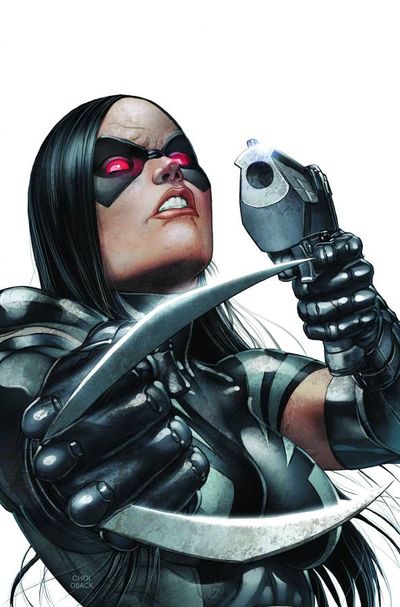
It’s kind of hard to talk about X-23 in X-Force, for reasons that may or may not be obvious. For those of you who don’t know, X-Force, unlike the regular X-Men (who are generally regarded as superheroes who save the world) are more like mutant assassins that quietly and permanently take care of issues, with the likes of Wolverine and Deadpool in their ranks. In early 2008, a new X-Force ongoing series was being put together under the penmanship of Chris Yost, so including X-23 in the roster seems like a no-brainer, right? I mean, when you’re putting together a team of mutant assassins, you may as well include the mutant assassin you co-created! Well, the problem is that up until this point X-23’s whole arc (which sort of culminated with her picking a new name in Target X) had been about becoming her own person, refusing to be a weapon for anybody and gradually turning into a normal young girl, or better yet, a hero. So all of a sudden Yost just says “Yeah, you know what, let’s just put that on the backburner and have her be a killer again, no biggie.” Even Wolverine has a problem with it, and the only way this can possibly work in-story is by turning Cyclops into a massive, insensitive douchebag – the exact opposite of the leader who vouched for Laura in New X-Men.
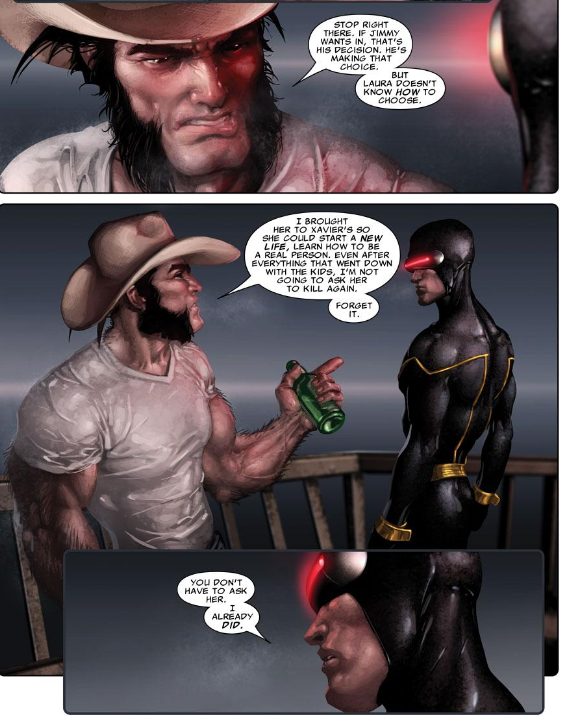
Other than that, the series itself isn’t bad. I mean, I’m personally not the biggest fan, and general consensus among fans is that the next iteration of X-Force (the one with Deadpool, and also the one that they’re currently making a movie out of) is much better, but there’s nothing offensively wrong with it. It’s fun, disposable comic book entertainment as far as I’m concerned. Regarding X-23, her major arc within the story basically involves her getting recaptured by Kimura and the facility that cloned her (like I said earlier, that and dealing with clones of herself are the two major story beats literally every writer hits at one point or another), which results in some fun, popcorn action. I think that just might be the biggest problem I have with X-Force – after some INCREDIBLE writing in Kyle’s series, Yost’s turn with X-23 just doesn’t feel earned. He doesn’t advance her character, he doesn’t develop her in any way, we don’t really learn anything new about her. While not offensive, the series is completely disposable, you could skip it and not miss a single thing in X-23’s grand journey.
Though I do have to give credit where credit is due – X-Force also gave us one of my absolute favorite X-23 moments ever (yeah, another one – I’ve got lots of favorite moments, they’re all great). I’ll keep the setup short, but at one point there’s a sort-of crossover between New X-Men and X-Force as the teams try to find a new batch of the Legacy Virus, which is essentially a mutant plague (think mutant smallpox in a vial). Obviously, that thing must absolutely never, ever be released, which becomes very problematic when X-23 ends up injected with the bulk of it. Thankfully, she’s got a plan – she’s gonna Ellen Ripley that shit.
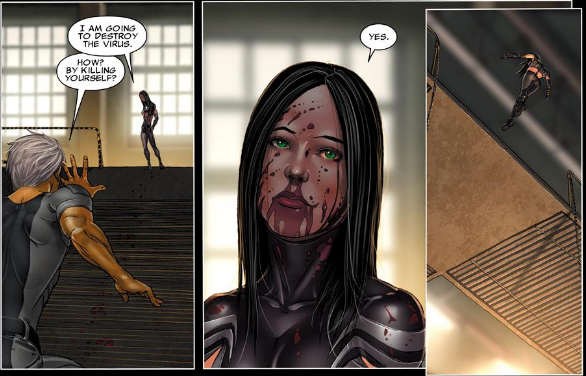
In a single word, she manages to tell us so very much about what she’s thinking. Even after all this time, she still sees herself as inferior to her peers, as a soulless object that can be disposed of with little hesitation should the need arise. Not only is it an incredibly badass act of self-sacrifice, it also tells us everything we need to know about the mind of X-23, in a single word. THAT is good storytelling. If the rest of X-Force was like it, maybe I would have loved that series a whole lot more.
Solo Series
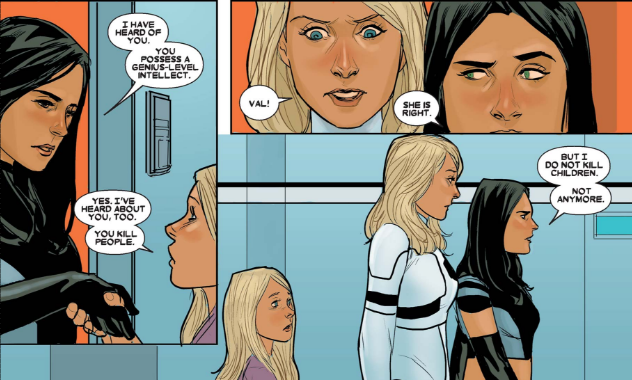
During her tenure on X-Force, X-23 made a myriad of guest appearances in other comics, mostly because Marvel was REALLY pushing for events at the time. World War Hulk, Secret Invasion, Fear Itself, Messiah War, Age of Apocalypse, and I’m sure I haven’t even scratched the surface here. In complete and utter fairness, as the X-23 super-fan that I am, I haven’t read most of these appearances. It’s just impossible to keep up with it all – she pops up for an issue here, then in an issue there, then she’s gone for three months and shows up in an issue of a completely unrelated comic… So instead I’m going to ignore most of these guest appearances and instead am going to jump to what we should really care about – X-23’s very first solo series! She’d done it, you guys! She was in the big leagues now, with a comic bearing her name! When I first heard that this was going to come out in 2010, I was beyond ecstatic. I mean, can you think of the possibilities of a Craig Kyle-helmed X-23 ongoing series? I orgasmed just thinking about it!
But alas, it was not meant to be. The writer’s pen went to Marjorie Liu, which, honestly, isn’t a bad choice, all things considered – she’d written Wolverine’s evil son Daken before in Dark Wolverine, and in all honesty I immensely enjoyed that series, so she seemed like a perfect fit. And let’s give credit where credit is due – she nails X-23’s personality and mannerisms. Sure, there were a couple of moments in which I went “Yeah, you know, this doesn’t quite seem like a very X-23 thing to do” (like when she undresses and goes running naked in the woods with a bunch of wolves for no reason, but then again, she’s naked quite a bit in that series), but for the most part, she seemed spot-on. When there was a danger of someone using trigger scent on her to force her to murder her friends, her first reaction was to immediately warn them of the danger and give them tactical advice on how to neutralize her in the most effective manner before she can do too much damage. And also look! Remember that theory I told you I had that X-23 didn’t actually have any feelings for Hellion and was just playing along to fit in?
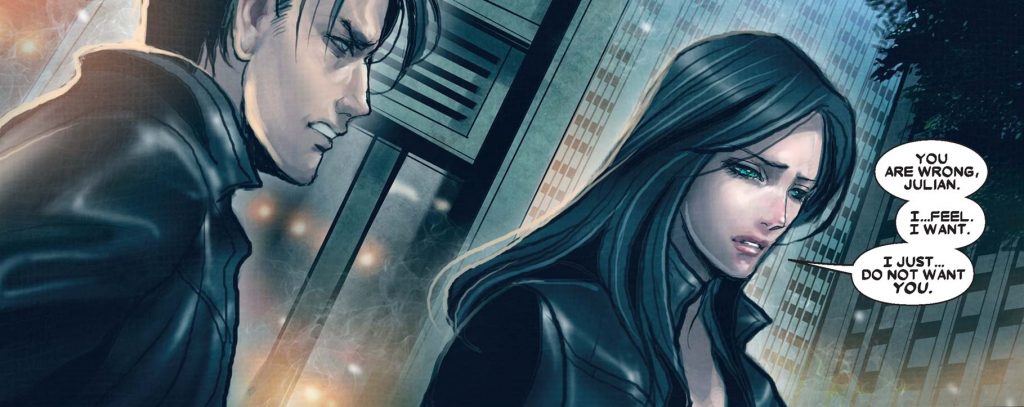
YES!!! I think that’s about as close as we’re gonna get to that being confirmed! Ooooh, that is beautiful! But seriously though, I genuinely enjoyed the characterization of X-23 in her solo series (again, naked running in the woods aside) – I felt like Liu did her character justice. With that said, however… This isn’t a series I would recommend. Its biggest problem is that it suffers from a horrible lack of focus that never quite helps it find its feet. To me, an X-23 series should have either had one long, ongoing narrative arc (a la Tom King’s Vision) or it should have simply been a collection of shorter stories about the character and her daily life (a la Matt Fraction’s Hawkeye). But in X-23, the focus and tone is CONSTANTLY shifting every few issues. To start off, the series begins as a tie-in to an atrociously stupid story arc in which Wolverine goes to hell and a demon inhabits his body, so we’re not off to a good start. From then until its cancellation at issue #21 (yep, they didn’t even make it to 23 issues), the series jumps from crossover to crossover. Look, there’s Vampire Jubilee, because that was a thing in 2010, for some strange and completely unexplainable reason that I’m sure had nothing to do with a movie franchise popular at the time. Hey, is that the Future Foundation? Let’s go see what they’re up to! Look, here’s Daken, Wolverine’s son – let’s cross over with his book! And of course during the course of that story Laura is going to get captured by the people who created her, because remember what I said about there being only 2 stories every writer has for her. At the end of it, you don’t feel like X-23 has really changed a lot, nor have you learned anything about her. And to be perfectly honest, I kinda wish Marjorie Liu was allowed to write an X-23 4-to-6 issue miniseries at some point, or a 1-issue annual or something. She clearly knows this character well, so I’d adore to read something that had a bit more focus in it!
TV, Games and Crossovers
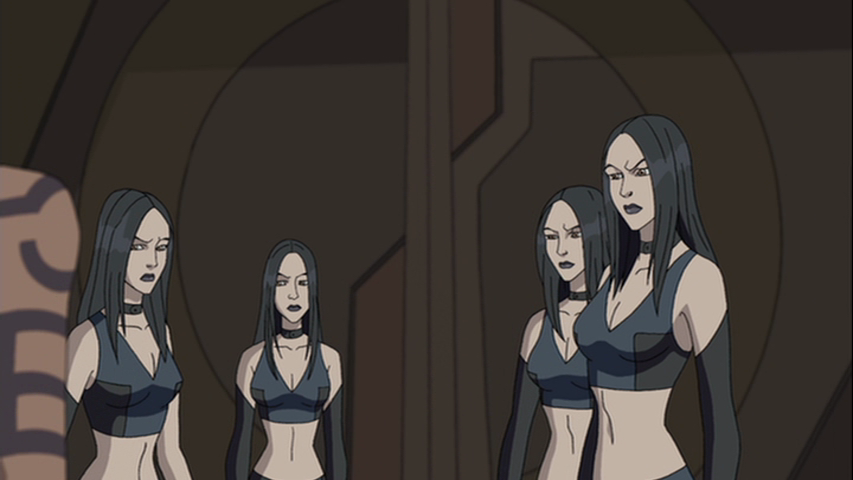
So, before we continue on with X-23’s comic book history, let’s take a bit of a break and examine a couple of her more interesting appearances up to this point. I primarily want to focus on the comics, so we won’t take too long, but feel free to skip to the next heading if you’re so inclined. About a year before her solo series started out, in August 2009, X-23 made her second animated appearance ever, in Wolverine and the X-Men. This time, her design is a lot more consistent with her comic appearance, and on top of that she also doesn’t speak, merely yells and grunts (thanks to the always amazing Tara Strong, who can make even yelling and grunting sound awesome – coincidentally, this marks the second time X-23 has been voiced by a My Little Pony actress). There’s just one problem with her, though… There’s four of her. Yep, for whatever reason, they decided that 4 X-23s were better than one. Well, they weren’t. Moving on.
Far more interesting was her, frankly, surprising appearance in 2011’s Marvel Vs Capcom 3. For those of you who don’t know, the Marvel Vs Capcom titles are actually hugely popular fighting games with a substantial audience that doesn’t just consist of comic book fans, so by including her in their character roster Capcom increased her popularity among casual audiences substantially. She looks and plays fantastically, with her playstyle emphasizing the quick and precise movements of a carefully trained assassin. Tara Strong returns to voice her, and she’s pretty much perfect… Though if I do have a complaint, it’d be that the X-23 of this game is way cockier than she needs to be, taunting opponents and cracking jokes, which I felt was rather out of character. But honestly? I think I can let that slide. It’s a fighting game, if the characters didn’t taunt each other after a win that would’ve been pretty boring! One thing that is also worth addressing is her theme song from the game. Most characters just received utterly amazing instrumentals (such as Hawkeye’s theme, which to this day remains one of my favorite comic book themes of all time), but there were a handful of vocal tracks in there, notably Deadpool’s theme, which quickly became famous for its incomprehensible lyrics. X-23’s theme also has lyrics, and, well…
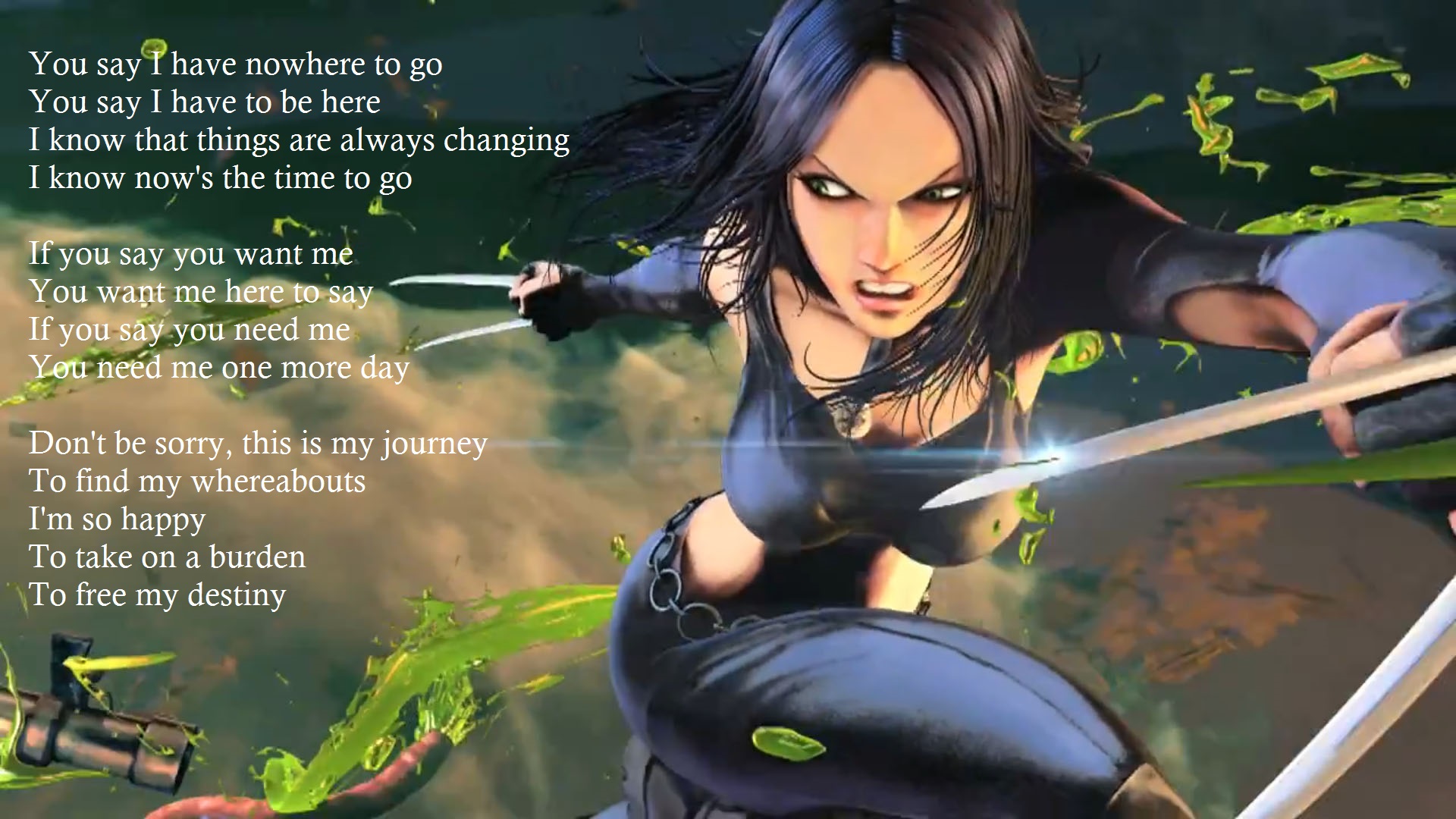
The theme sounds very pretty, but when you actually stop to look at the lyrics, it’s really worth asking if whoever wrote the song knows a thing about X-23, or just saw her character design and went “I know EXACTLY what she’s like!” I mean, I guess you can read the song as Wolverine begging her to stay as part of the X-Men while she knows that she must leave and follow her own destiny or something, but that is a gigantic stretch. Sure, in the past Laura has had to be persuaded to join various teams and schools, but that is because of her lack of confidence in herself and not because she believes she has to follow some kind of destiny or whatever. I mean, what is this journey to find her whereabouts, anyway? What is she looking for, anyway? A place where she belongs? Isn’t that precisely what she was running from in the beginning of the song? It doesn’t even make sense within its own context! I don’t know, maybe I’m just overanalyzing something that was just meant to sound good rather than to convey some kind of meaning (don’t forget that the song, while in English, was made by a Japanese composer, and in many Japanese songs lyrics are practically irrelevant and can even sometimes be nonsensical), but it has always bugged me the wrong way. I’ll probably never get the chance to talk about it, so I might as well do it here, right?
The last thing I’d like to discuss in this section is Laura’s first big crossover event (at least first big crossover event where she was a central part) – the Circle of Four, which happened on the pages of Venom and started in early 2012. Basically, the Gates of Hell open, and Agent Venom, Red Hulk, Ghost Rider (the Alejandra Jones version) and X-23 basically had to get together and prevent the apocalypse. Why those four in particular? I don’t know! Who cares? It’s fun! X-23 killing demons, yay! Alright, alright, I’m being a little unfair – while there may not be a meta reason why they’re all together, it’s explained pretty well why the four cross paths at the same time. Laura in particular is there because, you’ve guessed it, an eeeeeevil person is trying to clone her and turn the clones into weapons!
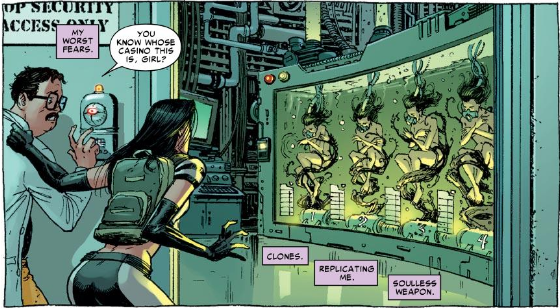
Yeah, remember what I said about there basically being two stories that literally every X-23 writer falls upon, her being captured or finding clones of herself? Are you starting to believe me now? At least I’m willing to give writer Rick Remender credit for being the first to use that plot device since Craig Kyle did it in Innocence Lost, and for also spicing things up a bit for making the clones symbiotes, which is… Yeah, it’s pretty cool. Another interesting aspect of the story is that it definitively answers the question of whether or not X-23 has a soul: The answer is yes, despite being a clone, Laura does, in fact, have a soul. Of course, this opens a whole new can of worms about what it takes to gain a soul in the Marvel Universe. Do all living creatures, be they clones or not, have unique souls? Do you gain a soul after you’ve established yourself as an individual? Or is it just because Laura is technically not an identical clone, and if she was identical she wouldn’t have had a soul? I don’t know, it’s one of those things that we probably shouldn’t be thinking about. But at least we can take solace in the fact that when Marvel inevitably kills Laura off to replace her with a younger, more ethnic Wolverine, she’ll be killing bad guys in Heaven.
Avengers Academy & Avengers Arena
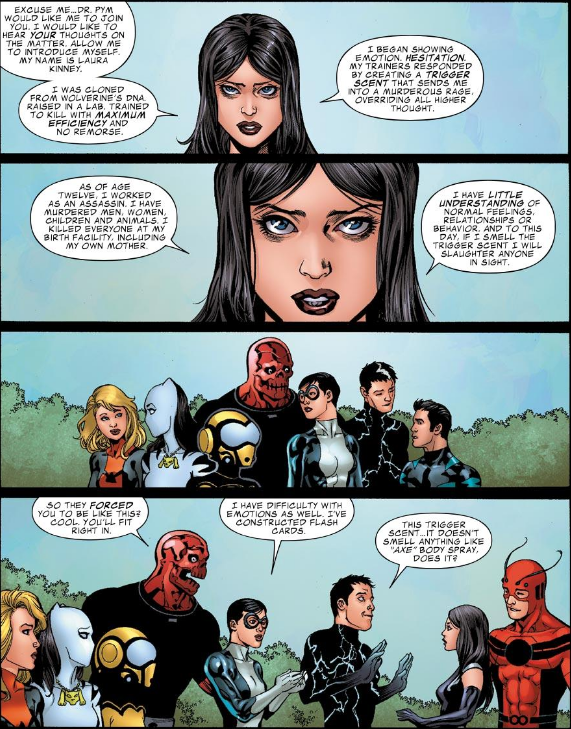
Shortly before her solo series was canceled in March 2012, in December 2011 Laura joined the cast of Avengers Academy – an ongoing series about the next generation of Avengers being trained by Hank Pym and a couple more ex-Avengers. Today, the name Avengers Academy is associated more with a terrible mobile game, but back then it actually stood for one of the best series Marvel had to offer. It was fantastic, and true story, it actually got a friend of mine into comics. It had an amazingly diverse cast, each with their own unique quirk, backstory and upbringing (if you don’t like Hazmat you clearly have poor taste in characters), awesome stories that built both the cast and the plot, its crossovers made sense, it was all-around amazing. The main premise is that the students of the Academy weren’t actually being trained to be the next generation of Avengers – they were just considered the most likely young metahumans to turn into villains, which is precisely why the Avengers decided to take them under their wing and try to stray them from that path. Naturally, as you can see from the page above, X-23 fit right in.
Sadly, Laura joined only at the tail end of the series, issue 23 (har har) out of a total of 39, and she did so alongside several other characters. As such, outside of the big Avengers vs X-Men crossover, she was really only part of one big storyline which actually did something completely different with her – for once, she didn’t deal with being imprisoned or with having to hunt down clones of herself, believe it or not! Instead, the main plot involved a “cure” for superpowers, which came pretty handy to some of the Academy students (like the aforementioned Hazmat, who was stuck in a hazmat suit for life because her power involves continuously emanating deadly radiation), but kind of sucks for Laura, who finds herself mortally wounded for the first time ever. It’s a fresh concept, and while the book doesn’t quite go anywhere with it, it’s important to remember that this is a team-based series with a very large cast, and Laura was kind of the runt of the litter. Obviously the focus would fall on the original characters whose stories have been developing since issue 1 rather than on the old characters that join more than halfway through. It’s understandable, and it doesn’t detract from the fact that Avengers Academy is still awesome, even if I wish it had more Laura in it.
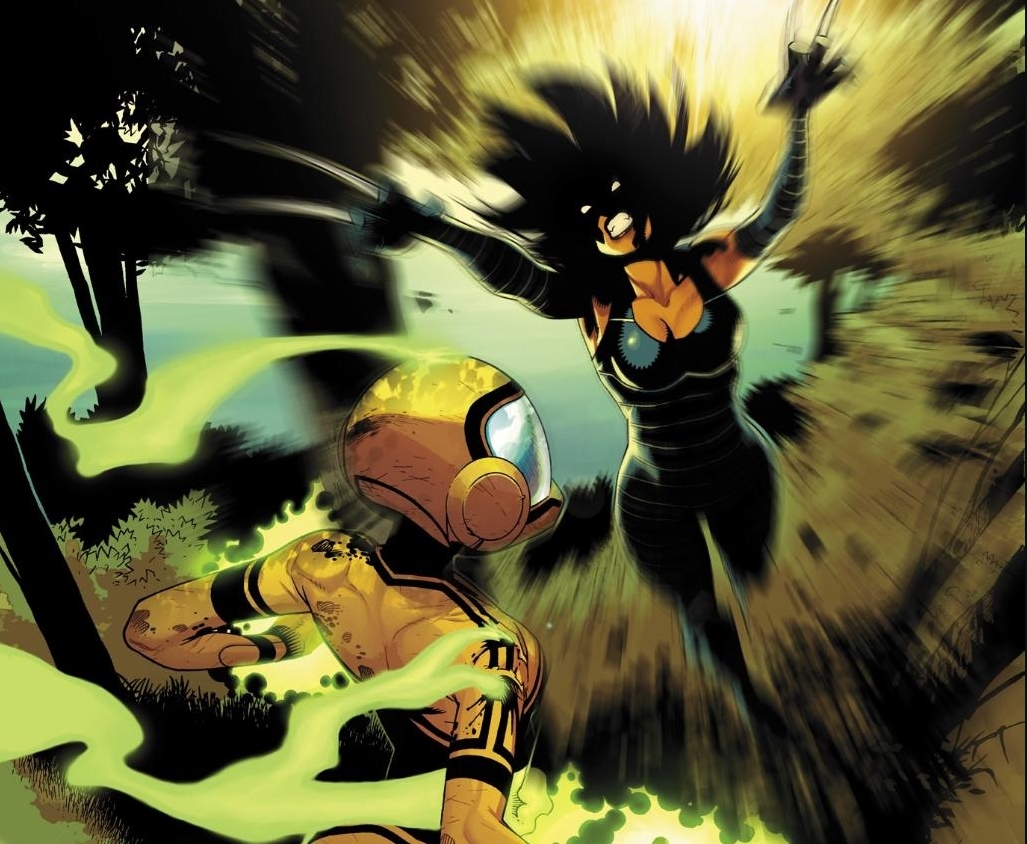
Following the cancellation of that series, many of its characters were pulled into a semi-sequel of sorts – Avengers Arena, whose first issue came out in December 2012, exactly a year after Laura first joined the Academy. In it, the students (X-23 included), two of the Runaways (Nico and Chase), a couple of solo characters (Juston from Sentinel, Cammi from Drax and most famously Darkhawk) and a bunch of original characters were all kidnapped by the supervillain Arcade, placed on an island and told that only one of them gets out alive – who that would be is up to them. If that sounds like a bad rip-off of The Hunger Games, which itself is a bad rip-off of Battle Royale, then you’re absolutely right. With that said, I still adore this series. A long time ago I actually had the chance to talk to writer Dennis Hopeless while he was doing a Facebook Q&A, and he seemed like a very intelligent guy who had put a tremendous amount of thought into the series. When it launched, a lot of people assumed that his intentions were basically “Hurr wouldn’t it be cool to kill off a bunch of kids for shock value”, while in reality death was always secondary to him (it’s why there’s actually just a couple of deaths in the whole series). The entire point of Avengers Arena was to take all of these characters and place them in a situation that’s grossly out of their comfort zone in order to see how they would react.
But there’s a single character here who’s not out of her comfort zone at all, isn’t there? No, good old X-23 has been specifically trained for this sort of thing, and if she wanted to she could kill every single person on that island within a week. She even comments on it herself a few times. Problem is, she doesn’t want to. At this point in her life, she’s the kind of person who would much rather die herself than hurt an innocent again, especially on the orders of some lunatic who thinks he has control over her. Instead, while one might assume that Laura would devolve into the primary antagonist of Avengers Arena and start murdering everybody, Hopeless writes her as the exact opposite – the one person who actively tries to save everyone rather than just try and survive. It is an unbelievably faithful portrayal and a brilliant exploration of her character in an already fantastic story. If you were one of the people who skipped it because you were turned off by the concept, I highly recommend that you give it a chance. Who knows, you might end up loving it just as much as I did.
And with that, we conclude our retrospective. Unfortunately, Laura Kinney died on that island, sacrificing her own life to save those of her friends and forever defying those who had programmed her to be nothing more than a weapon, even in death. At this point, X-23 has been dead for over three years now, and it doesn’t seem like Marvel has any plans to bring her back to… Yes, I know that she’s not really dead, but I’d still like to pretend, because nothing good happens to post-Arena Laura. You want me to talk about her anyway? Do I have to?
Sigh.
Alright. Let’s take a very deep breath and dive into All-New X-Men… By Brian Michael Bendis.
All-New X-Men
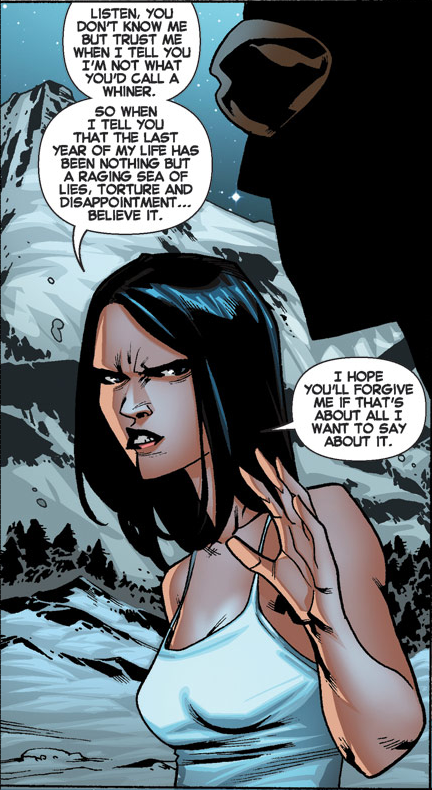
I am really not a fan of Brian Michael Bendis. At all. Like, not even a little bit. I’ll try not to turn this retrospective in a rant, but I think he’s a shoddy writer, has hilariously misinformed political opinions that he loves to shove into his comics, adores ignoring continuity and characterization that he hasn’t built himself and as of late has ruined more characters than I can count. Sure, he was good once (he was the guy behind Alias, the comic that introduced Jessica Jones, and also Ultimate Spider-Man, which introduced Miles Morales), but as of late he has done a whole lot more harm than good. If you’re searching for proof of his shoddiness, you need to look no further than All-New X-Men, which is the series that decided it would be a good idea to bring the classic X-Men from the 60s into the present and keep them stuck there for years for literally no reason whatsoever, or to suddenly out Iceman as “gay” in the most insulting way possible (Jean Grey saw it in his mind!) even though he’s had multiple relationships with women before and has literally shown no signs of being gay or even bi up until Bendis decided that he was playing for the other team. Entire articles have been written to get to the bottom of why modern X-Men comics suck so bad right now, and the root cause is Brian Michael Bendis, a man intent on destroying the Marvel Universe one chunk at a time.
But what I can never forgive is his treatment of my favorite comic book character of all time. If you for some reason decide to torture yourself by reading modern Bendis, you’ll realize that he basically has two character voices – a “male voice” and a “female voice”. And as you can see from the screenshot above, his “female voice” doesn’t suit X-23 AT ALL. She’s not supposed to be sassy or dismissive, nor is she supposed to wallow in her own misery. Laura Kinney is by far the strongest character I can think of in Marvel, and very few characters in general can rival her in terms of sheer strength of character. She is someone who has been forged in fire over and over and over again, literally since birth, someone whose heart (warm, full of life and love for everyone around her) is encased in thick steel that even she doesn’t quite know how to penetrate. Someone who keeps all of her pain inside because that is literally all she has ever done throughout her entire life. Someone who would sacrifice herself over and over just to make sure that those around her are safe and sound. She would not call herself a whiner, nor would she complain about how much her life sucks.
And you might think that this is just one out-of-context panel, but it’s not. The first few issues with her in it are all written like this, to the point where I had a very hard time actually picking a panel to showcase because they were all so bad. I have a confession to make – I never read the entirety of this series. I never even came close. I mean, it’s just painful. It’s like suddenly finding a sex tape of the girl you grew up alongside and realizing that her life now involves lots of drugs, alcohol and unprotected intercourse with strangers on camera. Why would you ever want to watch that? It’s disgusting, it’s painful, it’s humiliating for all parties involved. I refuse. Let’s move on.
The Logan Legacy & Wolverines
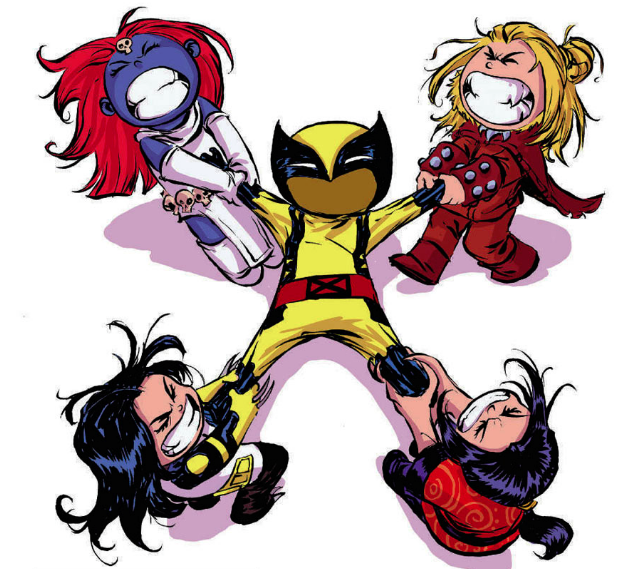
Once again I’ll try to be brief because, honestly, these stories are kind of pointless and aren’t all that interesting in the grand scheme of things. In late 2014, the storyline Death of Wolverine ended with a truly shocking and unexpected twist – the death of Wolverine. Of course, that wasn’t the first time Logan had died, or even the first time he’s died in the main continuity, but it was certainly the most notable one, and from the looks of it, it appears to have stuck… At least until the inevitable “Return of Wolverine” event which is going to bring him back from the dead in some cosmic X-Men-y way, like it always happens. But I digress. With Logan dead, the people closest to him found themselves entangled in a convoluted plot to grab their DNA so that some people from the “Death of Wolverine” series could get a healing factor implanted into them… Or something. I don’t know, honestly, the plot is mostly just an excuse to have a bunch of Wolverine-themed characters together in the same book, and from what I’ve read in reviews, most people aren’t awfully fond of The Logan Legacy. I can see why.
On a more meta level, that series, alongside its sequel Wolverines, which released a little bit later (January 2015), was supposed to answer the big question on everybody’s minds: With Logan dead, who was going to take up his mantle? Who was going to become the next Wolverine? The book presents several candidates, namely X-23 (obviously), Wolverine’s evil son Daken (who died at the end of his series, inexplicably came back to life, died again and then came back to life for this series), Sabretooth, Lady Deathstrike and, for some odd, unexplainable reason, Mystique. I mean, don’t get me wrong, I know that Mystique had a long and complicated history with Wolverine in the comics, but let’s be completely honest here, nobody even for a second thought that she was ever going to be the next Wolverine. The choice seems completely and utterly out of place, and as far as I can tell she serves no role other than to be the surprise antagonist of Wolverines. Personally, I would have replaced her with Deadpool. In the comics he gained his powers by having genes from Wolverine implanted into him, which qualifies him for being part of Logan’s legacy… And even though nobody was going to buy that he could ever be a real candidate for the next Wolverine, he was going to bring some humor and levity into an otherwise boring and dull story.
My biggest problem with Logan’s Legacy and Wolverines isn’t that they’re dull, however. Nor is it that they misrepresent X-23 in some way (they don’t as far as I could tell – in fact, she barely does anything in them, other than change her haircut). It’s that, at the end of the day, they’re completely pointless. Nothing changes. The characters don’t grow. Nothing amazingly interesting happens. And, worst of all, we don’t even get to learn who the next Wolverine would be! Instead, the series ends with a tie-in to the 2015 event Secret Wars, much like most Marvel series at the time. The June 2015 graphic novel Rage of Ultron (mostly released to coincide with a similarly named big-budget Hollywood motion picture) supposedly spoiled away the answer by showing Sabretooth as part of the Avengers, but we never learned whether that story is supposed to be canonical or not. I mean, it certainly doesn’t look like it now, but at the same time its ending (which sees MAJOR character changes) is reflected upon in the main Marvel universe, so… Does that mean Sabretooth was actually Wolverine for a little bit before quitting? Ah, it doesn’t matter. What matters is that Logan’s Legacy and Wolverines were mostly created to give us an answer we all wanted, and it completely failed to deliver. Boo!
All-New Wolverine
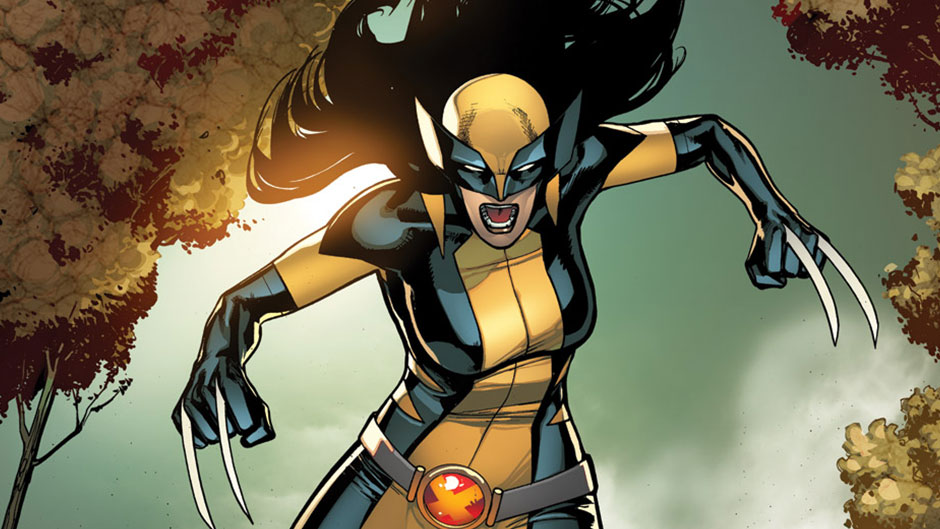
Fortunately, we didn’t have to wait too long to find our answer. In November 2015, we finally received an all-new, standalone series following the adventures of Wolverine, and what do you know, it turns out that our favorite clone got the job! To be perfectly honest, at the time I was still a little disillusioned from the way Laura was treated in All-New X-Men, so I was trying not to be too optimistic, but when I learned about it even I thought that this sounded like the best option they could have gone with – it was an example of Marvel recasting a classic character with a more diverse face (something that has been happening a lot in the company lately) that actually made sense and wasn’t just forced for the sake of diversity. I mean, who else are you going to have take over Wolverine’s job than the person who is literally him, only with two X chromosomes? She’s the best there is at what she does, and there literally couldn’t have been a better choice. Sure, subjectively speaking, maybe picking someone like Sabretooth or even Mystique as the new Wolverine could have made for better stories, but objectively, Laura was the best option, no questions asked.
With that said, though… I am not a fan of this series at all. Like, not even a little bit. I think that this is one of my least favorite series Laura has ever been in, though I do admit that this is a purely subjective opinion. All-New Wolverine has its fans – lots of them, and they’re very vocal about their love for the series. And that’s fine! I’m not saying that you shouldn’t like it, I’m only saying that I personally don’t. To be perfectly honest, this series has the exact opposite problem that Marjorie Liu’s X-23 had – it follows a tight, cohesive narrative with a clear direction, but the characterization of Laura herself is terrible. Tom Taylor writes her with nary an understanding of what makes her who she was. She’s funny! She cracks jokes! She’s well-adjusted! She’s got no mental issues whatsoever! She’s perfect, flawless and capable of everything! She has a high moral standard and refuses to kill anyone, even the people who deserve it! She lives in a neat, tidy apartment and is in a loving relationship with a boyfriend! She calls Wolverine Dad! It’s just so adorable and cute and wonderful… And it’s not X-23.
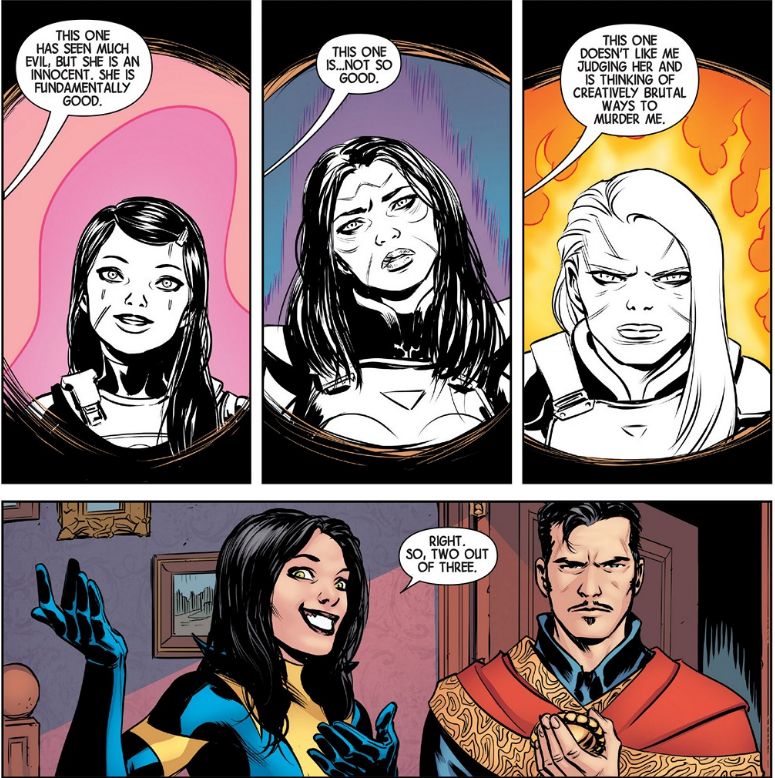
X-23 is none of those things, and there’s a ton of continuity errors here. For example, the no-killing thing. Where did that come from? In her appearance in Avengers Academy, she very explicitly and undeniably says that she would kill people who are a threat without hesitation, but the one thing she’d never do is kill an innocent. Hell, she killed plenty of people in The Logan Legacy and Wolverines, which happened months before All-New Wolverine in the canon! It’s implied that her rule is the result of something Wolverine told her during their time in X-Force, but X-Force preceded Avengers Academy by a full three years. Did it just take her a while to process it or something? There’s also the fact that she has never referred to Wolverine as ‘Dad’ once in any of her other series (trust me, I just read most of them to prepare for this). As a matter of fact, when introducing her to the X-Men, Wolverine explicitly called her his sister. Their relationship has been complicated, and they’re undoubtedly a family, but the fact that she acknowledges it so matter-of-factly comes completely out of nowhere.
What about her personality? In the beginning of the series, Laura is contacted by a group of people who have attempted to clone her, and several clones of her have escaped, with the group asking for her help to bring them back (yep, the good old “dealing with clones of herself” cliche). Laura reacts to this completely reasonably, agreeing to go look for the clones and just treating the whole thing like it’s no big deal… Instead of, y’know, screaming “YOU BITCHES DID WHAT?!” at them before slaughtering each one of the people responsible, like she should have. Not to mention, she continuously acts cute and funny, like most girls her age. But the thing is that she isn’t like most girls her age. That’s 90% of her character – being so unlike everyone else, and yet trying so hard to fit in, in her own way. She’s a gigantic Pinocchio metaphor, a manufactured puppet in a world of real girls. By taking that away from her, you strip her of her primary characteristic, and for what? To make her more “likeable”? To give her more quirky and funny moments? You don’t necessarily need to make your protagonist funny in order to have a lighthearted adventure. I’m all for X-23 having a lighter, more adventure-filled romp as Wolverine, but not at the cost of her character, especially since leaving her personality intact would have resulted in much better comedy. Laura is the perfect “straight man” – the humorless, too-serious-for-her-own-good type who’s all business and doesn’t know how to have fun (think Cable from Cable & Deadpool). So if you team her up with someone who’s wisecracking, funny and consistently trying to get under her skin, be it another superhero or just an annoying roommate/involuntary sidekick, that’s your recipe for comedy right there.
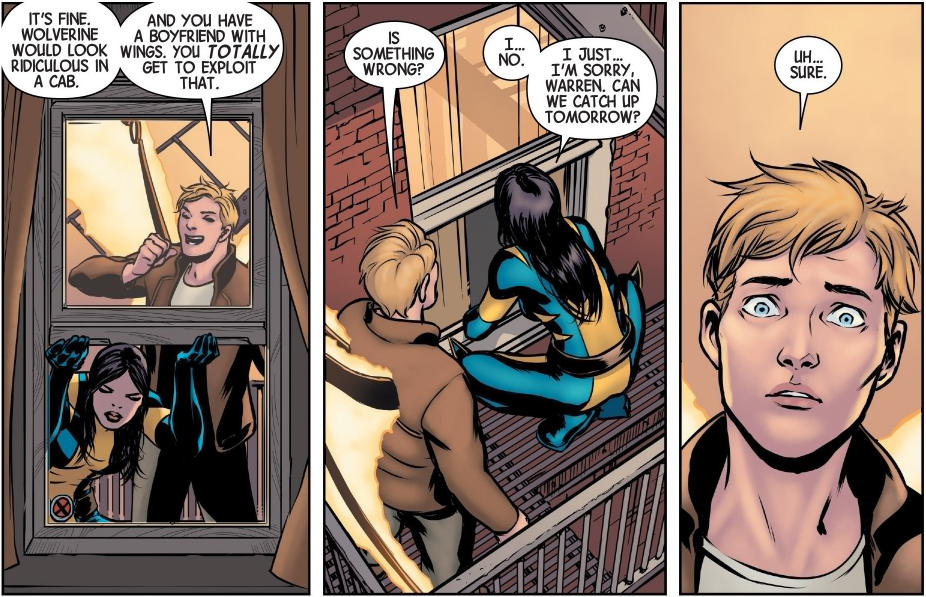
All-New Wolverine takes basically nothing from the character’s 13+ year history. It’s essentially a reboot, with an entirely new cast and an entirely new character in an entirely new role. This is a Laura Kinney who is a lot more concerned about what a bunch of guys on the Internet think about her than with, say, more existential things like whether she’s physically capable of feeling normal human emotion despite the fact that she has been genetically and psychologically engineered to be the perfect sociopath. This isn’t a smart book – it’s not pointless, it very clearly has a story direction and characters that evolve, but it’s clearly more concerned with pandering to the Tumblr reblogging crowd by giving them tons of cute and funny moments that are easily taken out of context and shared than with actually saying something new about its characters, or the human condition, or the world they inhabit. X-23’s storylines have always had certain themes attached to them, such as the issue of human morality (with questions like is it an evil thing to push someone created for fighting into a role that will ultimately involve more fighting) or human nature (a great juxtaposition that has popped up in the past is Laura being presented as more “real” than the people around her despite being manufactured in a lab). There is so much you can do with this particular character, and honestly, while Tom Taylor is very clearly a skilled and talented writer who knows how to craft stories and setpieces, I don’t think Laura was the right fit for him. His voice would be perfect for a character like Kate Bishop/Hawkeye, but X-23 just presents different themes than the ones he obviously wants to write.
And that’s not to say that I want Laura Kinney to remain stagnant, to always be stuck as the same miserable, abused 13 year old prostitute she was in 2005. She has to learn from her experiences and evolve as a character – for example, at the beginning of her career (Chris Claremont’s early version of her excluded) she spoke very formally and clearly, without using any contractions or adjectives to spice up her speech, which makes sense for someone whose whole world revolved around murder textbooks and teachers very specifically instructed to be very formal and impersonal with her. But as time went on, her speech gradually diversified due to the influence of the kids around her, so yes, I can absolutely buy the fact that she now speaks more or less normally. But it’s very hard to swallow a character change this drastic, especially when it has come completely out of nowhere. If X-23 learned that she shouldn’t kill, I can accept it. If she learned to be happier and have a sense of humor, that would be fine. If she learned to accept herself for who she was and not question herself, I wouldn’t complain. But this “character development”, as some have called it, comes completely out of left field. Excluding Bendis’ All-New X-Men, in which she acts completely out of character anyway, her personality and characterization have been consistent for the past 13 years. So if you want to suddenly change her, you have to earn that. We have to see it happen. I don’t know, maybe there can be, like, a mini-series or something bridging the gap between Wolverines and All-New Wolverine which explains her change in behavior and ideology. Marvel, if you’re reading this, call me! I wanna pitch you an idea!
Logan
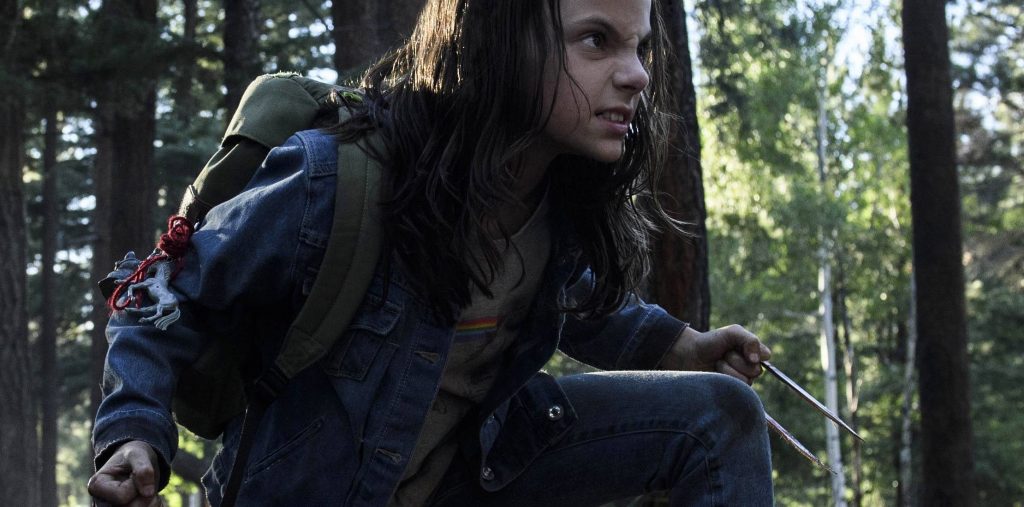
At long last, X-23 made her very first live-action appearance in 2017’s Logan, the final film in Wolverine’s very odd trilogy, and also the last time we’ll ever see Hugh Jackman portray the titular character on screen. Needless to say, people were split – half the audience were wondering just who the hell was this little girl who had Wolverine’s powers for no reason, and the other half simply squeed in joy over the fact that one of the most underrated characters in comics is finally getting some on-screen recognition. Her portrayal, as an eleven year old girl who just escaped from the people who made her, is very much inspired by Craig Kyle’s Innocence Lost rather than by anything later, with a couple of nods to Tom Taylor’s All-New Wolverine series, so you know I’m going to be pleased. But with that said, is her portrayal faithful to the comics, and if not, do the changes made to her character for the movie make sense within its context? To be perfectly honest, it’s a bit of a mixed bag. Mild spoilers for Logan follow.
The general idea of Laura being a young girl with Wolverine’s powers who was bred by a shady organization in order to be a weapon has been preserved, alongside the fact that only her claws have been bonded with adamantium rather than her entire skeleton. If you look at this promotional video detailing her origin (most of which also appears in the movie), you’ll see that some scenes are shot-for-shot recreations of Innocence Lost, such as the surgery to sharpen her claws or Laura being caught cutting herself immediately afterwards. And, just like the Laura from Innocence Lost, the little girl from Logan is mute for the majority of the movie, instead relying on actions and facial expressions to narrate her feelings and intentions. So obviously, a lot of the source material was translated verbatim… But then there’s also a slew of changes which, at least to me, were completely pointless. For example, Laura isn’t Wolverine’s clone – she’s his daughter, achieved through artificial insemination. At first I was okay with that idea, because let’s face it, cloning might be a bit too out there for a film as grounded in reality as Logan… But then we’re introduced to an actual Wolverine clone that comes completely out of nowhere and makes literally zero sense when you think about it (since that clone supposedly went from inception to fully grown in the span of weeks or months), so you just have to stop and ask yourself what was the point of any of it. If it were up to me, I’d have simply made Laura a clone and then replaced the actual clone with another character entirely, like Sabretooth.

On a similar note, the characters of Sarah Kinney and Zander Rice, while present in one form or another, have also been altered, and are kind of polar opposites of each other. Sarah is technically in the movie, in that she’s Laura’s mother figure in the facility who treated her well when nobody else would, but she’s not her biological mother, she’s just a Mexican nurse called Gabriella (likely a nod to Gabby, a prominent character in All-New Wolverine). I’m fine with Sarah not being Laura’s biological mother, especially since it gives us a fantastic line from her to Wolverine (“She isn’t my daughter, but I love her. You may not love her, but she is your daughter”), but why change her like this? Why not just have her be Sarah Kinney? If changing her race from white to Hispanic was an attempt at diversity, then it’s kind of a wasted one, since she’s only on screen for about two minutes anyway… Which is just slightly more than the time dedicated to Zander Rice, who, despite sharing a name with his comic counterpart, has literally nothing to do with him. Comic Rice is brash, impulsive, arrogant, way over his head. He’s not out to achieve some sort of ideal, he’s out for Weapon X’s blood as revenge for his father’s death. Movie Rice is the smooth-talking, calm and intelligent British villain that Deadpool made fun of just a year ago. He casually shrugs off the fact that Wolverine killed his father, to the point where it’s not even clear why he brought it up at all, and believes in controlling the mutant population, or something like that. He was a pointless character, and I (like many critics) believe that he should have been cut from the movie entirely, with the sole villain being Donald Pierce.
But by far the biggest change done to Laura is the language she speaks. Like I mentioned, Laura is mute for the majority of the movie. At some point about 3/4 in, without absolutely any provocation whatsoever, all of a sudden she starts to speak… Spanish. It’s clear throughout the movie that she understands English. It becomes clear later that she speaks English. It is very clear to her that Logan doesn’t speak a word of Spanish. So I am genuinely struggling to understand the thought process of her choosing to be silent for the majority of the film, only to then starts speaking a language that she knows the person she’s addressing won’t understand. And nothing prompts this at all. Logan just says “Thanks”, and she responds with “De nada”. What makes it even odder is that just a few minutes later they have an intense argument where Logan chooses not to take her where she wants to go. Wouldn’t it make more sense if she spoke then? Logan considers her a passive presence and makes all of her decisions for her, until she finally speaks up, tells him a very firm “No” and insists on going. That honestly makes a lot more sense to me than her just babbling on in Spanish for a while until he does what she wants him to. Sure, it’s a funny scene, but it makes no sense, and furthermore, as critics like Doug Walker have pointed out, it creates a disconnect between the audience and the character. It would have been a better choice to just have her be fluent in both English and Spanish – she talks to Logan in English, she communicates with the other children who were imprisoned with her in Spanish.

With all that said, you might think that I hate Logan and the Laura in that movie, but… I don’t. I really, really don’t. The frustrations I’m listing here are less because I think they failed in capturing the character and more because I believe they were this close to nailing her and then just lacked the time to polish the script with another draft. As a whole package, Laura is great, and a huge part of that comes from her actress, Dafne Keen, who just might be one of the most spectacular child actors I’ve ever seen in my life. If Fox decide not to go with her for a new Wolverine franchise, I can absolutely guarantee you that she’ll be headlining another big franchise within a few years, mark my words – someone somewhere looking for a talented young teen will snap their fingers and say “I want her”. Dafne shares screentime with one of the greatest living actors, Patrick Stewart, and with possibly the best comic book movie character of all time in his best film, and she still somehow manages to outshine them both. She’s able to be funny, cute, dramatic, menacing, and oh so badass, sometimes in quick succession. She’s amazing, and handles her fight scenes spectacularly. And I’m happy to say that in the movie Laura fights the way she ought to – if Logan is like a blunt instrument or a wild animal, she’s like a scalpel, a trained assassin with surgical precision. It’s fantastic, and it just really, really sucks that a couple of dumb, pointless choices like “Hey, let’s just have her speak Spanish for some reason” detract from what was otherwise going to likely have been remembered as one of the most promising new cinematic superheroes of the modern era.
Future

If Logan proves to be successful, that’s going to definitely increase Laura’s status in general. Since members of the X-Men are currently banned from appearing in the overwhelming majority of Marvel games (basically everything made after mid-2015 can’t use the X-Men), so it’s likely safe to assume she’s not going to make a comeback in the recently announced Marvel Vs Capcom 4, or any other games, for that matter. And while there’s always a chance that she could end up in the mainstream X-Men movies (admittedly with some time-travel shenanigans, since Logan takes place in the future), we currently have a new X-Men movie, Deadpool 2 and New Mutants all filling the slate, so the earliest possible movie that she could make a return to would be X-Force, which currently doesn’t even have a date, but I’d wager 2019/2020. In the realm of the comics, it appears that All-New Wolverine is doing pretty well for itself, selling an average of 30,000 copies a month (which isn’t that bad for a comic book in today’s economy), and while issue 15 (the last one I could find sales numbers for) just barely cracked the top 100 best-selling comic books of December list, I personally am not expecting it to be cancelled any time soon. Though considering the fact that “classic” X-23 is going to become very popular very soon, maybe it might be a good idea to launch a “back to basics” series to run alongside it, designed to appeal to fans like me who prefer the older, slightly darker and more existential take on the character? It’s just an idea, but it makes sense to me. No one says she can’t have two series running side by side! In all honesty, that’d be a downgrade from Wolverine’s 6-7 concurrent series a month!

